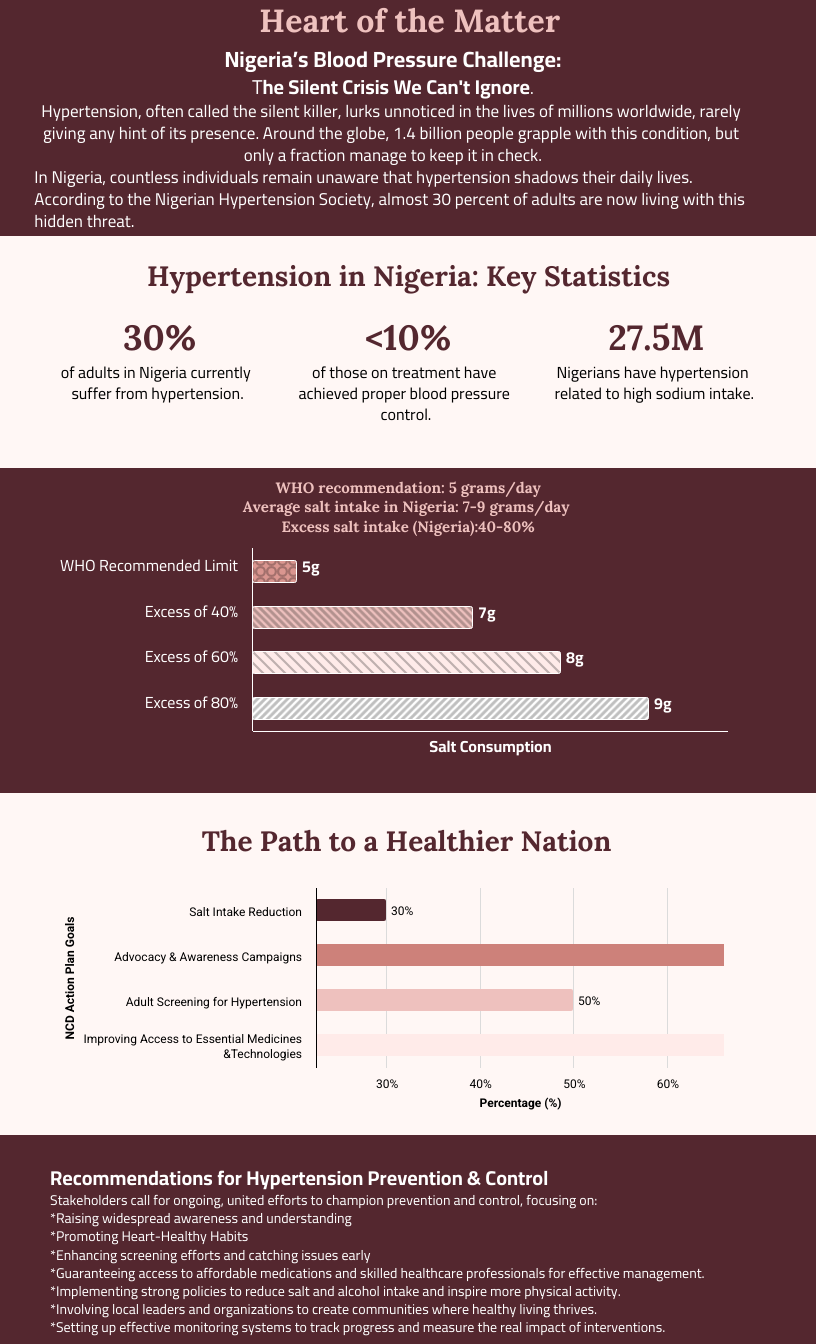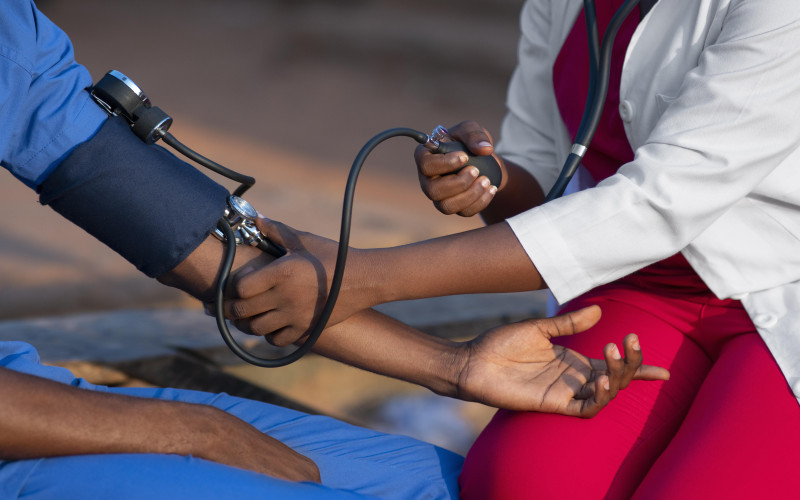Rakiya A. Muhammad
Danjumah Aliyu had no idea he was living with hypertension until a sudden bout of illness sent him to the hospital. As he sat in the waiting room, his heart raced like a drum, and his vision began to blur. Only then did doctors reveal his blood pressure was dangerously high, underscoring how hypertension often strikes without warning and carries deadly risks.
“The doctors told me that my blood pressure was much higher than normal and that I needed immediate medical care.”
According to the World Health Organisation, “hypertension (high blood pressure) is when the pressure in your blood vessels is too high (140/90mmHg or higher)”
Shocking Stats: Facing the Reality
The Global Hypertension Report paints a staggering picture. In 2024, 1.4 billion people lived with hypertension. Yet, only a little over one in five managed to keep it under control.
WHO Director-General Dr Tedros Adhanom Ghebreyesus underscores the immense toll of preventable deaths caused by hypertension.
“Every hour, more than 1,000 lives are lost to strokes and heart attacks caused by high blood pressure. Most of these deaths are preventable.”
In Nigeria, millions live under the shadow of hypertension. Approximately 30 percent of adults currently suffer from hypertension, according to the Nigerian Hypertension Society.
Yet, like Aliyu, many Nigerians remain unaware of their condition until serious complications strike, despite hypertension’s widespread grip on the nation.
Simeon Isezou, Professor of Medicine and Consultant Cardiologist, points out, “Many people with this condition are unaware of having it. Among those on treatment, fewer than 10 percent achieved proper blood pressure control. Many do not take their medicines regularly.”
He notes high blood pressure as the main cause of strokes, heart failure, lasting kidney problems, and heart attacks, which can lead to death or disability. “This is particularly significant in Nigeria, where one in every three adults has hypertension. It has no symptoms until serious damage has been done to the body.”
Consider the story of Dayo, a 50-year-old father of three. Dayo lived a relatively healthy life, with no apparent health complications. That was until one morning when his left side suddenly went numb, and he struggled to form words. He was rushed to the hospital, where doctors confirmed a stroke caused by undiagnosed hypertension.
Dayo’s experience highlights the silent yet deadly nature of this condition and underscores the critical importance of early diagnosis and effective management to prevent such life-altering complications.
Hypertension silently undermines not only health but also national productivity and resources. If not addressed, increasing healthcare costs and lost productivity could erode the nation’s GDP, threatening long-term economic stability.
The Global Hypertension Report provides further economic context, noting that, from 2011 to 2025, cardiovascular diseases, including hypertension, are projected to cost low- and middle-income countries approximately $3.7 trillion in direct and indirect expenses.
The report also highlights healthcare inequity, noting that a vast majority (93 percent) of high-income countries can provide all WHO-recommended hypertension medications, while only 28 percent (seven out of 25) of low-income countries are able to do so, thereby aggravating financial pressure on public health systems.
Many people in the community cannot afford medicine for high blood pressure, while others must spend a significant portion of their income on it.
For instance, consider Mike Chukwuma, who spends N10,000 every month to buy medicine for himself and his wife.
This significant expenditure amounts to 20 percent of his total monthly income of N50,000.
Breaking Barriers: Challenges & Trials
Public health experts in a Policy Brief on improving hypertension control in Nigeria ,identify key barriers to improving hypertension outcomes in Nigeria, including inadequate financing for non-communicable diseases (NCDs), poor integration of NCD care into primary health services, medication stockouts, limited health insurance coverage, and a lack of workforce capacity for hypertension management. From the patient perspective, low health literacy, poverty, inability to afford medications, poor access to care, and challenges with long-term adherence remain major barriers.
The Brief centred early policy implications for the wider adoption and scale-up of the Hypertension Treatment in Nigeria (HTN) Program, which uses a combined care model based on the World Health Organization’s HEARTS package. This method can be summarised in three key actions: check early, treat promptly, and keep track regularly. The package includes patient registration, team-based care, training and supervision, and a clear treatment plan.

The HTN Program, with an initial scope focused on the Federal Capital Territory, aims to bridge critical gaps in hypertension care by implementing the WHO HEARTS multilevel package across 60 primary healthcare centres in the region.
The initiative brings together a national standard treatment protocol. It promotes fixed-dose combination therapy and streamlines patient registration. The package also rewards collaborative care among health workers. It empowers patients with home blood pressure monitoring and personalized health coaching.
“The HTN Program also implemented a drug-revolving fund to improve the accessibility of blood pressure-lowering medications,” the team reveals.
“Results demonstrate more than 90% treatment rate and more than 50% hypertension control among more than 21,000 registered patients from January 2020 to December 2023.”
They note that if sustained and scaled up through adoption and implementation in routine public health policies and practices, the HTN Program could help reduce Nigeria’s hypertension disease burden and serve as a template for delivering integrated NCD care in primary care.
Lifestyle Hacks, Dietary Detox: The Heart of Change
Urbanisation is reshaping lifestyles. Junk food, sugary drinks, and desk-bound jobs fuel the hypertension crisis. Still, many people remain unaware and cut off from vital screening and education. However, small lifestyle adjustments can help manage these urban challenges.
Imagine swapping one daily soda for water or taking a short walk during lunch breaks. These micro-steps are attainable entry points that can create a ripple effect toward healthier living. Small wins like these foster sustained behaviour change.
President of the Nigerian Hypertension Society, Prof.Isezou, explains, “Obesity, a sedentary lifestyle, and a diet rich in salt, fats, and sugar are currently the main factors behind the rising burden of hypertension in Africa.”
He recommends consuming traditional African food derived from roots, stems, and leaves, and regular exercise and maintaining an optimum weight, for the prevention of hypertension. He also calls for the adoption of a traditional African active lifestyle that includes trekking, gardening and native African dances. “Regular blood pressure checks should be encouraged in the family. Ultimately, every family, household, or home in Nigeria should have a blood pressure apparatus for regular blood pressure checks.”
The NHS helmsman calls on federal lawmakers to enact a law compelling companies to label the contents of salt, fat, and sugar on food packages appropriately.
Recent reports show a strong link between high sodium consumption and rising hypertension rates in Nigeria. About 27.5 million Nigerians, or 14% of the population, have hypertension tied to excessive salt intake. Many consume an average of 7 to 9 grams of salt per day, which exceeds the World Health Organization’s recommended limit of 5 grams.
Dr Salma Anas, the Special Adviser to the President on Health, points out that this escalating trend significantly elevates the risk of cardiovascular diseases and strokes. Severe complications, such as end-stage renal disease, are also increasing.
Unlocking Solution for Lasting Change
To tackle this growing health concern, Dr Anas reveals Nigeria has launched comprehensive initiatives. These include the National Multi-Sectoral Action Plan for the Prevention and Control of Non-Communicable Diseases. The plan aligns with the WHO SHAKE technical package for salt reduction. It sets targets to reduce salt intake to less than 5 grams per day, approximately one teaspoonful. It also encourages consuming 3 to 5 servings of a variety of fruits and vegetables, totalling at least 400 grams per day.
The strategy further outlines ambitious goals to cut dietary sodium by 30% over the next five years as part of Nigeria’s national guidelines. Measures include establishing sodium limits in packaged foods and conducting widespread public education campaigns on healthy eating. These also involve regulating food and beverage advertising, especially targeting children and adolescents.
Recognizing hypertension as a national health priority, she adds that the Federal Government is implementing reforms to enhance control and management. These include integrating hypertension screening into primary healthcare, overhauling the insurance system, and developing a new national strategic health plan.
Furthermore, efforts aim to improve access to care through the Global Action on Non-Communicable Diseases platform. Priorities also include improving the healthcare system for critical surgeries and care for blood vessels, reducing reliance on imported medicines, and maintaining a steady supply of essential drugs.
These initiatives are crucial for tackling hypertension nationwide, but lasting progress depends on sustained public and stakeholder action.
“Achieving sustainable improvements requires a comprehensive approach, stresses Aisha Hassan, a public health analyst. “This includes strengthening healthcare systems, increasing access to affordable blood pressure monitoring and treatment, and promoting healthy lifestyles through balanced diets, regular physical activity, and reduced salt intake.”
She underscores the importance of educating patients on medication adherence and building partnerships with the private sector and NGOs to support initiatives for hypertension management.
Aisha notes that ongoing monitoring and adapting interventions are crucial for achieving long-term success and a lasting positive impact.
“This is the tipping point,” she says,” the moment for stakeholders to drive a wave of change, creating a healthier future for Nigeria.”


